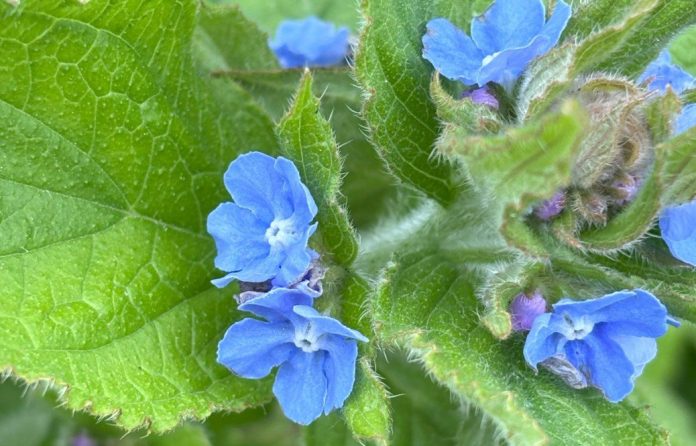Green alkanet (Pentaglottis sempervirens), a perennial plant belonging to the borage family, is both admired for its vibrant blue flowers and lamented for its invasive tendencies. Native to southwestern Europe, this plant has become naturalized across much of the UK, thriving in gardens, hedgerows, and disturbed habitats. While its resilience and decorative appeal make it a popular plant for informal gardens, green alkanet poses challenges for gardeners seeking to manage its spread.
Identification
Green alkanet is easy to recognize, especially when in flower. Its main identifying features include:
- Leaves: Coarse, hairy, and ovate leaves with a rough texture. The leaves remain green year-round.
- Flowers: Striking, vivid blue, five-petaled flowers resembling those of forget-me-nots, with a white central eye. Blooms appear from spring to early summer.
- Height: The plant typically grows to a height of 60-90 cm (2-3 feet).
- Roots: A deep, black, woody taproot that anchors the plant and makes removal difficult.
Habitat and Distribution
Green alkanet thrives in moist, shady conditions but is highly adaptable. It is commonly found in gardens, woodland edges, roadside verges, and other disturbed sites. Its ability to colonize both cultivated and wild spaces has led to its spread throughout much of the UK.
Historical Introduction to the UK
Green alkanet was introduced to the UK as a garden ornamental in the 18th century. Its bright flowers, which attract pollinators like bees, and its ability to thrive in poor soils made it a desirable addition to cottage gardens. However, its vigorous growth and tendency to self-seed allowed it to escape cultivation and establish itself in the wild.
Ecological Impact
Although not officially classified as invasive in the UK, green alkanet can be problematic in certain contexts:
- Competition with Native Flora: Its rapid growth and extensive root system enable it to outcompete native plants, particularly in woodlands and hedgerows.
- Soil Stability: The plant’s robust taproot can stabilize soil in eroded areas, but its dominance may alter the composition of local plant communities.
- Pollinator Support: On the positive side, its flowers are an important source of nectar for bees and other pollinators, particularly in urban areas where floral resources may be scarce.
Control and Management
Managing green alkanet can be challenging due to its persistent root system and prolific seed production. Effective control measures include:
- Manual Removal: Digging out plants, including their deep taproots, is the most effective method for small infestations. Care must be taken to remove all root fragments to prevent regrowth.
- Cutting and Mowing: Regular cutting can weaken plants over time but will not eradicate them without addressing the roots.
- Mulching: Applying a thick layer of mulch can suppress seedlings and reduce light availability, limiting growth.
- Herbicides: Spot treatment with herbicides may be necessary for large infestations, but this should be done cautiously to avoid harming non-target plants.
Cultural and Horticultural Uses
In addition to its ornamental appeal, green alkanet has been used historically for various purposes:
- Dye Production: Like many borage family plants, green alkanet contains compounds that can produce a red dye from its roots.
- Cottage Gardens: Its cheerful blue flowers and low maintenance requirements made it a staple in traditional cottage gardens, where it provided early-season color.
- Wildlife Gardens: Despite its invasive tendencies, it remains popular among gardeners seeking to support pollinators.
Conclusion
Green alkanet’s dual identity as a charming ornamental and a persistent garden escapee reflects the complexities of managing non-native plants. While its ecological impact in the UK is less severe than that of some other invasive species, gardeners and conservationists should remain vigilant to prevent its unchecked spread. By understanding its growth habits and historical context, we can appreciate its beauty while mitigating its challenges.




